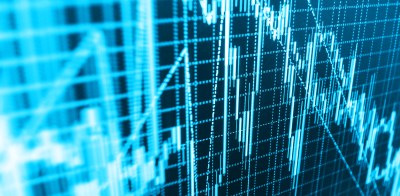Like many asset classes in 2018, high yield bonds ended the year in negative territory as a broad-based “risk-off” sentiment took hold in the fixed income markets. Despite the challenging environment, corporate fundamentals remain strong and default rates remain near all-time lows.
Against this backdrop, some investors may wonder: Is now the time to own high yield? To help answer this question, we look at the current fixed income environment as well as the performance of high yield and traditional core fixed income assets over previous market cycles.
Eroding sources of stable income
Many investors have historically turned to their fixed income portfolio as a source of stability and income. And while a 30-year bull market in bonds helped deliver both income and capital preservation, the last five years illustrate how significantly times have changed. Yields and returns have fallen while volatility has increased.
Bloomberg Barclays U.S. Aggregate Bond Index
| Average yield | Annualized return | Periods of negative monthly returns | |
| Last 5 years | 2.5% | 2.5% | 40% |
| Prior 30 years | 6.3% | 7.7% | 29% |
Last 5 years represents December 31, 2013 to December 31, 2018. Prior 30 years represents December 31, 1983 to December 31, 2013.
Furthermore, despite the Fed raising rates nine times over the last three years, 10-year U.S. Treasury rates ended 2018 at 2.69%. We believe the likelihood of history repeating itself over the next 30 years is quite low. In our view, today’s fixed income market requires an active approach in order to construct a balanced fixed income portfolio – composed of both stabilizers and return enhancers.
- Stabilizers: Fixed-rate investment grade assets, such as those represented in the Bloomberg Barclays U.S. Aggregate Bond Index (the Barclays Agg), may serve as a source of stability and protection. These assets tend to perform better on a relative basis when interest rates fall and volatility increases, as we saw in the fourth quarter of 2018. (The Barclays Agg returned 1.64% in Q4 2018.)
However, investing in a traditional fixed income portfolio means investors must assume lower yields and a higher degree of interest rate risk as compared to investments that may serve as yield and return enhancers.
- Return enhancers: These investments reside outside of a “core” fixed income portfolio and may include high yield bonds, bank loans, emerging market debt or structured products. Like any investment, these assets carry their own risks – primarily credit risk.
High yield bonds tend to underperform traditional fixed income assets during periods of market volatility but typically offer higher yields and may serve as a buffer against rising rates.
The ability of a traditional fixed income portfolio to deliver both income and stability has significantly diminished over time. Five years of lackluster yields, as represented by the Barclays Agg, suggest income-seeking investors know this all too well.
The larger consequences of low yields
Low yields not only impact investors’ income, they also limit the potential for meaningful capital appreciation should interest rates decline. From 1983 to 2013, the 10-year Treasury yield fell 878 bps, which boosted bond prices and significantly contributed to the Barclays Agg’s total return. With interest rates now near historic lows, rates have limited room to fall, putting a cap on potential capital appreciation.
Conversely, the Barclays Agg’s low current yield reduces the income available to “cushion” returns when rates rise and bond prices fall. We saw this firsthand in 2018. While there were discrete periods of rising and falling yields throughout the year, the 10-year Treasury yield rose only 28 bps. Despite a relatively rangebound year for rates, the Barclays Agg returned just 0.01% as the income generated did not provide sufficient cushion to offset price declines caused by the modest rate increase.
We see further evidence of these challenges when looking back over the past three market cycles. For purposes of our discussion, we define a market cycle as a period in which high yield spreads widen beyond 850 bps, a relatively extreme sell-off for that market. We compare high yield bond performance against the Barclays Agg at different points in the cycle.
Examining performance across credit market cycles
We examine two consecutive time periods for each market cycle.
- First, we span the points in time when high yield spreads are at their lowest (or tightest) and widest. This captures the sell-off period that one would expect to present the weakest performance for high yield1 and strongest relative performance for the Barclays Agg.
- Second, we consider the two years following the endpoint of the widest spreads. This is intended to capture the period of recovery that tends to follow a spread-widening period.
- Last, we compare the returns of the two benchmarks over the entire cycle. This is intended to highlight if overall fixed income returns could benefit from an allocation to high yield despite experiencing a market sell-off.
In all three market cycles, the Barclays Agg outperformed high yield during the sell-off periods, and high yield outperformed the Barclays Agg during the two-year recovery periods. However, the data shows an interesting divergence between total relative performance during the first market cycle and the two that followed.
In the first cycle, the Barclays Agg outperformed high yield overall. Yet in the two most recent cycles, high yield outperformance during the recovery periods more than offset underperformance during the sell-offs. In fact, during the most recent cycle, high yield outperformed the Barclays Agg by nearly 1,000 bps cumulatively.
Annualized returns during credit market cycles
| Dotcom bubble/recession | Great Recession | Oil price crash | |||||
|---|---|---|---|---|---|---|---|
| Sept. ’97–Oct. ’02 | May ’07–Nov. ’08 | June ’14–Feb. ’16 | |||||
| Oct. ’02–Oct. ’04 | Nov. ’08–Nov. ’10 | Feb. ’16–Feb. ’18 | |||||
| HY bonds | Barclays Agg | HY bonds | Barclays Agg | HY bonds | Barclays Agg | ||
| Sell-off | -0.7% | 7.6% | -23.7% | 4.7% | -5.0% | 2.8% | |
| 2-year recovery | 22.6% | 5.2% | 38.8% | 8.8% | 12.7% | 1.0% | |
| Total market cycle | 5.4% | 6.9% | 7.4% | 7.0% | 4.3% | 1.8% | |
Source: Bloomberg. Barclays Agg refers to the Bloomberg Barclays U.S. Aggregate Bond Index, and HY bonds are represented by the Bloomberg Barclays U.S. Corporate High Yield Bond Index.
We believe the difference in returns across the market cycles can be attributed to declining returns of the Barclays Agg during sell-offs. In the first cycle, the yield of the Barclays Agg heading into the sell-off was 6.2% and 10-year Treasury yields were at 5.7%.2 This resulted in two primary benefits for returns. Not only did the higher current yield help returns for the Barclays Agg throughout the period, but the higher starting level for 10-year Treasury yields allowed for additional capital appreciation as yields fell over the course of the cycle. In the subsequent two cycles, not only was the level of current income generated by the Barclays Agg lower due to its lower starting yield, but the magnitude of the decline in Treasury rates was smaller, allowing for less capital appreciation.
Looking beyond core fixed income
In light of the reversal in relative performance of traditional fixed income portfolios over the past three market cycles, and the challenges in today’s market, we believe a strong case can be made for allocating a portion of investors’ portfolios to high yield bonds alongside traditional core fixed income allocations.
While different areas of the fixed income market perform differently in the various phases of a market cycle, we believe structural changes in the interest rate environment over the past several years may encourage investors to look beyond traditional core fixed income allocations and diversify their holdings within fixed income, including high yield bonds.
Bloomberg Barclays U.S. Aggregate Bond Index is a broad-based benchmark that measures the investment grade, U.S. dollar-denominated, fixed-rate taxable bond market.
Bloomberg Barclays U.S. Corporate High Yield Index measures the USD-denominated, high yield, fixed-rate corporate bond market.




